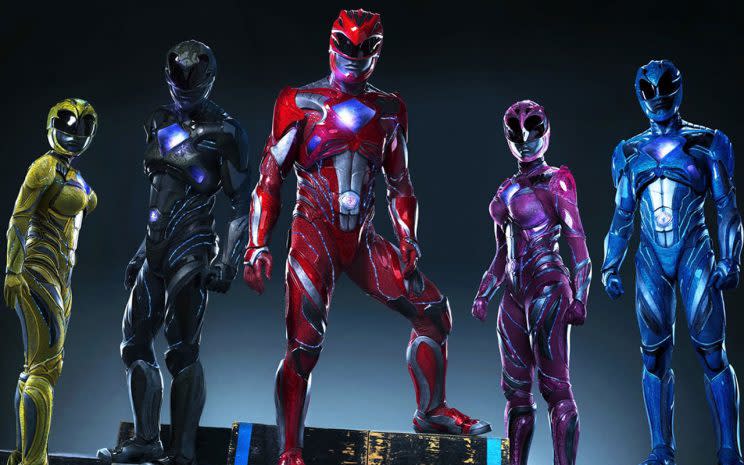'Power Rangers' Review: A Makeover, an Endless Origin Story — and Still Not Much Personality

By Owen Gleiberman, Variety
After 90 minutes of hip and hollow teen banter, woefully generic origin story, and molehill-posing-as-mountain-size triumph (our heroes spend half the film learning how to morph, when all that comes down to is getting their color-coordinated chintzy plastic sci-fi armor suits to snap into place), Power Rangers finally uncorks one of those high-flying digital-blitzkrieg action finales that was mocked in Birdman as the essence of blockbuster decadence. It is indeed, but to put it in movie-junk-food terms: Just because you know a sequence like this one is bad for you doesn’t mean that it’s not fun to watch.
In the battle royale that’s the big payoff of Power Rangers, our heroes face off against Rita Repulsa, the alien supervillain from the TV show’s first season — this is no mere retread; it’s Power Rangers classic! — who is played, by the redoubtable Elizabeth Banks, as a leering and mottled punk dominatrix serial killer with a fixation on gold that marks her as a witch-princess for our time. She wanders into a jewelry store and literally eats the gold finery, melting it down into her crystalline gleaming-gold staff; she’s got hunks of gold wedged into her face, as if it were part of her biological ecosystem. She does everything but write an editorial for The Wall Street Journal arguing that America should go back on the gold standard — though depending on how this franchise, and the Trump administration, works out, just give her time.
Rita wants to lay her long-taloned fingers on the Zeo Crystal, an object that will allow her to destroy the planet. It’s hidden at a Krispy Kreme franchise in downtown Angel Grove, Calif., and to that end she summons her ultimate coup de gold: a 100-foot-tall monster who looks like a cross between the Devil and the winged figure of Mercury, except that he’s made entirely of molten gold that never stops smelting and flowing, like the world’s most expensive lava. If the special-effects legend Ray Harryhausen were to look down from the clouds on this towering liquid-gilt demon, he’d say that it was fantastic. And he’d be right. I’d add a dollop of praise for Banks’ triumphant barbaric snarl. As for the Power Rangers, they’re part of the sequence too — they come to the rescue in metal ships shaped like lizards — but they’re the most innocuous of heroes in search of a real movie.
Why reboot the Power Rangers now? The answer is as obvious as it is depressing. In 1993, when Mighty Morphin Power Rangers debuted on Fox Kids, the show ricocheted off the rise of superhero culture, yet at the time superhero culture wasn’t something we were drowning in. These one-note high-school versions of Iron Man — leaping, flying, armor-wearing, and butt-kicking — seemed as thin and derivative as the Japanese tokusatsu TV series from which MMPR was adapted, yet the show filled a niche. A lot of people in their late 20s and early 30s now look back on Mighty Morphin Power Rangers with an affection as primal as that reserved, by a previous generation, for the most hard-to-defend John Hughes movies. (Quick: If She’s Having a Baby and season two of MMPR fought each other, who would win? Never mind.) There was even a big-screen version. Mighty Morphin Power Rangers: The Movie was released in 1995 and made an underwhelming $38 million. It was 95 minutes of genial trash that, like the show, seemed designed to turn kids into throwaway action zombies. (It probably worked.)
The new version tries to get all designer-techie and “ambitious” about rebooting the Power Rangers concept. Zordon, the Rangers’ mentor, is played by no less than Bryan Cranston, who appears as a giant face hologram, looking like a digital Wizard of Oz recast as a Toysmith Pin Art figure. And the morphing is now a much more major deal, since it mimics the scaly-blue metamorphosis of Jennifer Lawrence as Mystique. The new kids who would be Power Rangers — ne’er-do-well Jason (Dacre Montgomery), the Captain Kirk of the group; the haughty feministic Kimberly (Naomi Scott); Trini (Becky G), with her sexually alternative pride; Billy (RJ Cyler), a geek as nervous as he is brilliant; and the kickass mama’s boy Zack (Ludi Lin) — are portrayed like characters out of X-Men: The High School Musical. But this is also a rock & roll car-chase Power Rangers, meant at times to evoke the Fast and Furious films (best track: Social Distortion’s punk “Ring of Fire”). Alpha 5, the Rangers’ trusty automaton, is now a hubcap-headed droid voiced by Bill Hader as if he’d gone missing from an upcoming Star Wars sequel.
The thing is, it’s all franchise window dressing. What it can’t cover up is that the characters in Power Rangers have all the depth and idiosyncrasy of walking talking robo-teen action figures. How will a movie like this one do? In the minds of the people who made it, it was obviously conceived to be a blockbuster, one that would cut a swath across the demos and generations. But it seems likelier that the movie will earn the 2017 equivalent of the so-so grosses the 1995 movie did. The irony is that 25 years ago, Mighty Morphin Power Rangers was launched as superhero fodder for kids, and there was indeed a place for it, but we’re now so awash in superhero culture that kids no longer need the safe, lame, pandering junior-league version of it. They can just watch Ant-Man or the PG-13 Suicide Squad. Safe, lame, and pandering have all grown up.
‘Power Rangers’: Watch a trailer:
Read More from Variety:

